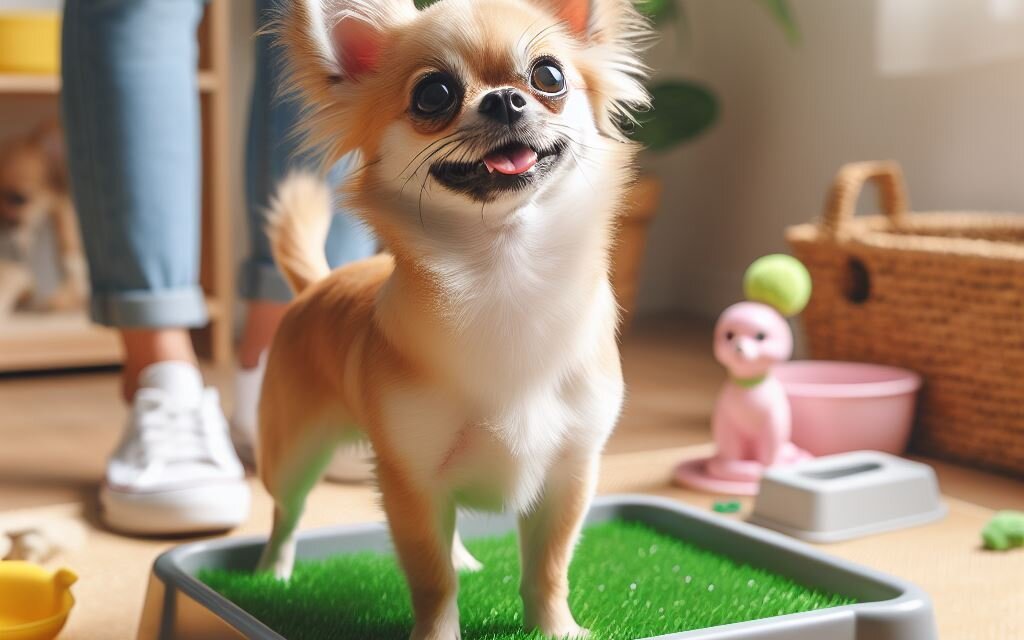House training a dog can be a challenging task, especially if you live in an apartment or have limited access to outdoor spaces. This is where an indoor dog potty can come to the rescue. An indoor dog potty is a convenient solution that allows your furry friend to relieve themselves indoors, saving you the hassle of frequent trips outside.
Benefits of an Indoor Dog Potty
1. Convenience: One of the biggest advantages of an indoor dog potty is the convenience it offers. Whether you have a busy schedule, bad weather conditions, or limited outdoor space, having an indoor potty allows your dog to relieve themselves whenever they need to, without having to wait for you to take them outside.
2. Easy House Training: Indoor dog potties can be a great aid in house training your furry friend. By providing a designated spot for them to do their business, you can establish a routine and train them to use the potty consistently. This can significantly speed up the house training process and reduce accidents around the house.
3. Suitable for All Dogs: Indoor dog potties are suitable for all dogs, regardless of their size or breed. Whether you have a small toy breed or a large breed, there are a variety of indoor potty options available to accommodate their needs. From grass patches to artificial turf, you can choose the one that works best for your dog. check Article on common health issues.
Types of Indoor Dog Potties
1. Grass Patches: Grass patches are a popular choice for indoor dog potties. They provide a natural feel and texture, making it easier for dogs to transition from outdoor to indoor potty training. Some grass patches are even equipped with a drainage system to prevent any mess or odor.
2. Artificial Turf: Artificial turf is another common option for indoor dog potties. It mimics the look and feel of real grass, but without the maintenance. It is easy to clean and can be a durable and long-lasting solution for your dog’s potty needs.
3. Pee Pads: Pee pads are a convenient and disposable option for indoor dog potties. They are made of absorbent material and can be easily disposed of after use. Pee pads are particularly useful for small dogs or puppies who may have difficulty holding their bladder for long periods.
Tips for Using an Indoor Dog Potty
1. Choose the Right Size: When selecting an indoor dog potty, make sure to choose the right size for your dog. It should be large enough for them to comfortably use without feeling cramped.
2. Establish a Routine: Consistency is key when it comes to house training. Establish a routine and take your dog to the indoor potty at regular intervals, especially after meals and naps. This will help them understand when and where they should go.
3. Positive Reinforcement: Use positive reinforcement techniques such as treats and praise to reward your dog for using the indoor potty correctly. This will encourage them to continue using it and reinforce good behavior.
4. Clean Regularly: It is important to clean the indoor dog potty regularly to maintain hygiene and prevent any unpleasant odors. Follow the manufacturer’s instructions for cleaning and disinfecting the potty to ensure a clean and sanitary environment for your dog.
Benefits of Using an Indoor Dog Potty
There are many reasons why you might want to use an indoor dog potty for your furry friend. Some of the benefits are:
- Convenience: You don’t have to worry about taking your dog outside every time they need to go, especially if you live in a high-rise building, have bad weather, or have a busy schedule. You can also leave your dog alone for longer periods of time without worrying about accidents or messes.
- Hygiene: An indoor dog potty can keep your home clean and odor-free, as it collects and contains your dog’s waste. You don’t have to deal with dirty diapers, wet pads, or smelly grass. You can also prevent your dog from getting infections or diseases from outdoor germs or parasites.
- Comfort: An indoor dog potty can provide your dog with a comfortable and natural place to do their business, especially if they are used to grass or soil. It can also reduce stress and anxiety for your dog, as they don’t have to hold it in or wait for you to take them out. They can also avoid the discomfort of cold, hot, or wet surfaces outside.
Types of Indoor Dog Potties
There are many types of indoor dog potties available on the market, each with its own features, pros, and cons. Here are some of the most common ones:
- Potty Pads: These are thick-lined, disposable pads that are typically used when housetraining puppies. They are easy to use and replace, and they contain attractants to entice your dog to use them. However, they can be expensive, wasteful, and messy, as they can leak, tear, or get chewed by your dog. They can also confuse your dog, as they might think that any soft surface is a potty spot.
- Indoor Grass: These are sections of real or artificial grass that mimic the outdoor environment for your dog3. They are natural, biodegradable, and odor-neutralizing, and they can help your dog transition to outdoor potty training. However, they can be costly, bulky, and hard to clean, as they require regular watering, trimming, and washing. They can also attract bugs, mold, or bacteria, and they can deteriorate over time.
- Pee Pods: These are plastic containers that hold a sponge-like material that absorbs and solidifies your dog’s urine4. They are easy to clean and dispose of, and they can trap and eliminate odors. However, they can be pricey, non-environmentally friendly, and limited, as they only work for urine and not feces. They can also be unstable, noisy, or unappealing for your dog, as they might not like the texture or sound of the pod.
- Training Trays: These are plastic trays that hold puppy pads, artificial grass, or other potty materials5. They are simple, versatile, and durable, and they can keep your dog’s paws dry and clean. However, they can be slippery, flimsy, or unsightly, and they can still cause spills or leaks. They can also require additional purchases of potty materials, and they can be hard to train your dog to use.
- Self-Cleaning: These are advanced devices that automatically flush, rinse, and dry your dog’s waste. They are convenient, hygienic, and odorless, and they can save you time and hassle. However, they can be very expensive, complicated, and power-consuming, and they can malfunction or break down. They can also scare or intimidate your dog, as they might not like the noise or movement of the device.
How to Choose the Best Indoor Dog Potty for Your Dog
The best indoor dog potty for your dog depends on several factors, such as:
- Your dog’s size, breed, age, and personality: You should choose an indoor dog potty that suits your dog’s physical and behavioral characteristics. For example, if you have a large, active, or playful dog, you might want to choose a spacious, sturdy, and durable potty. If you have a small, timid, or sensitive dog, you might want to choose a cozy, quiet, and gentle potty.
- Your home’s space, layout, and design: You should choose an indoor dog potty that fits your home’s available space, floor type, and decor. For example, if you have a limited, carpeted, or elegant space, you might want to choose a compact, leak-proof, and discreet potty. If you have a spacious, tiled, or casual space, you might want to choose a large, grassy, or colorful potty.
- Your budget, lifestyle, and preferences: You should choose an indoor dog potty that matches your financial, personal, and environmental goals. For example, if you have a low, busy, or eco-friendly budget, lifestyle, or preference, you might want to choose a cheap, easy, or reusable potty. If you have a high, relaxed, or luxurious budget, lifestyle, or preference, you might want to choose a pricey, convenient, or self-cleaning potty.
How to Train Your Dog to Use the Indoor Dog Potty
Training your dog to use the indoor dog potty can be challenging, but rewarding. Here are some tips to help you succeed:
- Choose a location: You should choose a location for your indoor dog potty that is accessible, consistent, and comfortable for your dog. You should avoid places that are too noisy, crowded, or distracting, such as near the TV, the door, or the food bowl. You should also avoid places that are too isolated, inconsistent, or uncomfortable, such as in the basement, the bathroom, or the balcony.
- Introduce the potty: You should introduce the potty to your dog gradually and positively. You should let your dog sniff, explore, and get familiar with the potty, and praise and reward them for showing interest. You should also associate the potty with a cue word, such as “potty”, “go”, or “pee”, and use it every time you take your dog to the potty.
- Establish a routine: You should establish a routine for your dog’s potty breaks, and stick to it as much as possible. You should take your dog to the potty first thing in the morning, last thing at night, and after meals, naps, playtime, or training. You should also monitor your dog’s signs of needing to go, such as sniffing, circling, or whining, and take them to the potty immediately.
- Reinforce the behavior: You should reinforce your dog’s potty behavior with praise, treats, toys, or affection. You should reward your dog as soon as they finish their business, and use a cheerful and enthusiastic voice. You should also avoid punishing, scolding, or yelling at your dog for accidents, as this can make them fearful, anxious, or confused. Instead, you should calmly and quickly clean up the mess, and take your dog to the potty again.
How to Maintain Your Indoor Dog Potty
Maintaining your indoor dog potty is essential for keeping it clean, fresh, and functional. Here are some tips to help you do it:
- Clean the potty regularly: You should clean the potty at least once a day, or more often if needed. You should remove and dispose of any solid waste, and empty and rinse any liquid waste. You should also wash and sanitize the potty with mild soap, water, and vinegar, and let it dry completely before using it again.
- Replace the potty materials: You should replace the potty materials as often as recommended by the manufacturer, or when they become worn, dirty, or smelly. You should follow the instructions for disposing or recycling the potty materials, and use new ones that are compatible with your potty model.
- Refresh the potty odor: You should refresh the potty odor with natural or pet-friendly products, such as baking soda, lemon juice, or lavender oil. You should sprinkle, spray, or rub the products on the potty, and let them sit for a few minutes before wiping them off. You should also avoid using harsh or toxic products, such as bleach, ammonia, or alcohol, as they can harm your dog or the potty.
An indoor dog potty can be a game-changer for house training your furry friend. It offers convenience, ease of use, and a practical solution for those who live in apartments or have limited access to outdoor spaces. By choosing the right type of indoor potty and following a consistent routine, you can successfully train your dog to use the potty indoors, saving you time and effort in the process.


 Mini Labradoodle: A Complete Guide
Mini Labradoodle: A Complete Guide  Dapple Dachshund: A Unique and Lively Breed
Dapple Dachshund: A Unique and Lively Breed  Pocket Pitbull: A Compact Canine Companion
Pocket Pitbull: A Compact Canine Companion  Preparing for an Adventure: A Golden Retriever Packs Its Suitcase
Preparing for an Adventure: A Golden Retriever Packs Its Suitcase  The Blue Merle Australian Shepherd: A Captivating and Unique Breed
The Blue Merle Australian Shepherd: A Captivating and Unique Breed  Long Haired Dachshund: A Guide to This Charming Breed
Long Haired Dachshund: A Guide to This Charming Breed
Ace of Base — шведская поп-группа, образованная в 1990 году. Их музыкальный стиль сочетает в себе элементы поп-музыки, дэнса и электроники. Группа стала популярной благодаря хитам “All That She Wants”, “The Sign”, “Don’t Turn Around” и “Beautiful Life”. Эти композиции не только покорили чарты во многих странах мира, но и остаются классикой жанра до сих пор. Ace of Base оставили неизгладимый след в истории поп-музыки, их мелодии до сих пор радуют слушателей по всему миру. Скачать музыку 2024 года и слушать онлайн бесплатно mp3.
Dating is a truly joyful experience. Sometimes we lose sight of this truth in our search for the right Online dating site